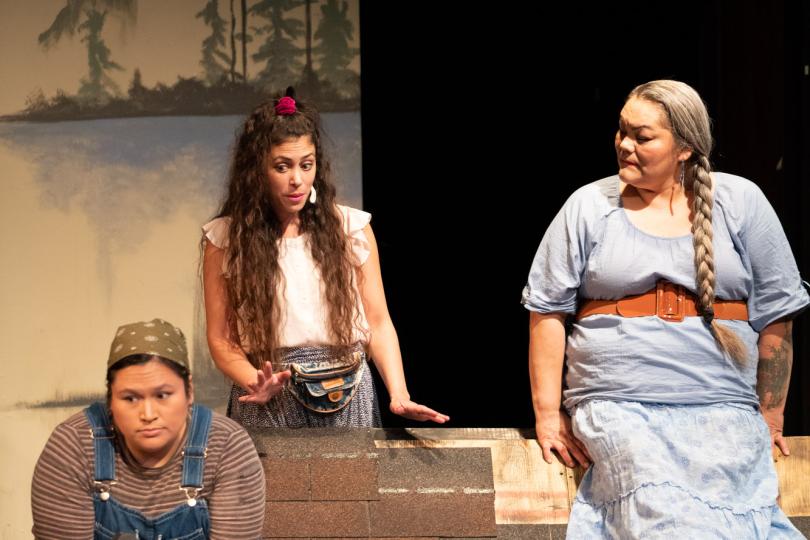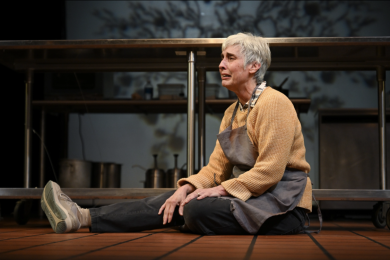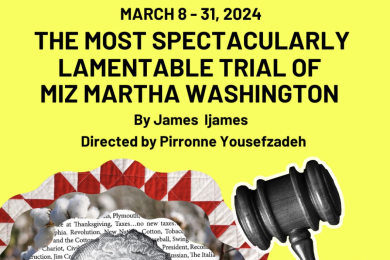4 to 6 hours to Toronto

For New Native Theatre’s 10th anniversary, Artistic Director Rhiana Yazzie thought it was time to bring the classic The Rez Sisters to the Minneapolis/St. Paul theatre scene. The Rez Sisters focuses on seven women (mostly sisters and half-sisters), who live on the fictitious Wasaychigan Hill Indian Reservation and dream of winning Biggest Bingo in the World in Toronto. What starts out as speculation and daydreaming soon becomes action as all seven women work to make the opportunity possible. Cree playwright Tomson Highway captures a moment in time by juxtaposing dominant culture, such as Patsy Cline and scrunchies, with the realities of “rez” life.
In her program note for this production, New Native Theatre’s Artistic Director and Founder Rhiana Yazzie considers the history of The Rez Sisters and its reception, both in Canada in the 1980s and in NYC in the 1990s (some examples available here and here). I quote from Yazzie at length:
“When the NY Theatre Workshop produced THE REZ SISTERS in 1994, racist reviews prevailed in their short sighted understanding of Native characters and the Native women’s portrayal of indigenous people ---most likely not one of these reviewers had even met a real live Native American before--- yet they were tasked to critique their cultural expression, values, morals, history, poverty, and creativity. I would be lying if I still didn’t have some reservations about how mainstream audiences here in Minneapolis-St. Paul accept or don’t accept the Native characters on our stages. But that’s not why NNT exists.
We exists for ourselves, the Native community. We are not here to educate non-Natives but when non-Native audiences see our shows, a much more deep connection can made because we’re not pre-digesting content for anyone and we’re inviting everyone in to get to know us from our own perspective and to sit at our table.”
I very much enjoyed getting to know these women. While some of the characters strokes are broad, such broadness can be almost unavoidable with such a large cast, particularly when so much of the characterizations happen while the women are together plotting or arguing as a group; it would be very hard to argue that the large female cast in Fiddler on the Roof or Radium Girls is any less broad... That being said, within the chit chat, gossip, and storytelling, each character is given a moment to shine. Director Shannon Davis (Potawatomi/Ojibwe/Sami) and Artistic Director Yazzie prioritize giving opportunities to newer actresses who, given dominate theater culture, may never have had the chance to be part of such a large-scale production. That opportunity is welcome, and this cohesive cast gives a moving and thoughtful performance. Highlights include the Ybarra’s high-energy Annie (she imparts the perfect amount of resilience and childishness to the role) and Yazzie as Marie-Adele, whose moments of strength and fragility propel the story forward.
At the start of the play, Pelajia Patchnose (Jei Harald-Zamora, Spirit Lake Dakota) works on the roof of her home, bemoaning the dirt roads of Wasaychigan Hill and threatening to leave unless they are paved. Philomena Moosetail (Fawn Mason, Red Lake) sits with her, teasing her about her futile threats. The play bookends with the sisters on the same roof, which provides the right kind of coda for a tale that has no easy solutions or answers. Fast-moving Annie Cook (Rebekah Crisanta de Ybarra, Maya Lencha), interrupts their revery with talk of The Biggest Bingo In The World and sets the play on its trajectory. Along the way, we meet gossip and aspiring chef Veronique St. Pierre (Inez DeCoteau, Turtle Mountain) with her developmentally delayed adopted daughter Zhaboonigan Peterson (April Morrison, Oglala/Rosebud), Emily Dictionary (Angelique Morgan, Leech Lake), whose leather and bandana speak to her years of riding with an all-women motorcycle gang, and Marie-Adele Starblanket (Rhiana Yazzie, Dine’/Navajo), who has late-stage cervical cancer and 14 children. Even though the rez sisters spend much of the play talking about the men in their lives, there is only one male actor, who double tasks by playing both the trickster god Nanabush (disguised as a bird) and the Bingo Caller (Tito Ybarra, Red Lake).
This gets to what I found most effective about The Rez Sisters: the men who affect these women’s lives never appear on stage. Unable to see the women interact with the men in their lives, we are forced to cobble together a picture of these men and their relationships from the women’s accounts. This puts us at epistemic parity with the rez sisters: just like Marie-Adele, we don’t know if Eugene’s sobriety can withstand her death; just like Emily Dictionary, we don’t know if Big Joey’s proclivities for bondage are a harmless kink or will someday cause her grave harm; just like Annie, we don’t know if Fritz the Cat actually loves her or is just using her; just like Pelajia, we don’t understand the chief's plans or priorities for the reservation. We never meet these men, and so can’t make up our minds -- we have to listen and trust the rez sisters. By focusing only on the women’s interactions with each other, it makes the actions of others’ feel mysterious and dangerous; it underscores the precariousness of the rez sisters’ lives.
The costuming and innovative blocking in this play deserve special mention. Asa Benally (Dine’) has perfectly understood the characters: Annie’s red cowboy boots, Philomena’s amazing belt, and Maire-Adele’s perfectly worn out and draped dress are just a few of the standouts. During the long drive to Toronto, the rows of the car (just simple rows of folding chairs) come apart and rearrange themselves to give us insight into the different conversations and goings on. This was probably my favorite part of the play, as the blocking and the dialogue fit so well together.
BIG BINGO
While it might be easy to dismiss Bingo as a way to get rich quick, one only needs to look at the proliferation of multi-level marketing to see that the allure of easy money never goes out of fashion. What I found interesting is how the playwright couches Bingo in Wasaychigan Hill life and lore. One of the most compelling moments is when the women discuss Bingo Betty, the legendary Bingo winner. From the women’s description of Bingo Betty, it is clear that the rez sisters worshiped her. She would play 24 cards while only allowing her companions 3 each. She played with chips, not the daubers used nowadays. She would go and play the Big Bingo! The tones of admiration used for Bingo Betty are not echoed for any other person during the rest of the play. As far as the rez sisters are concerned, she was the pinnacle. This makes it all the more understandable why they pin their hopes on winning the Biggest Bingo In The World: Bingo Betty showed them how a women could be successful and set the terms of engagement, and she did it through Bingo.
The Rez Sisters is not pre-digested, and I am quite thankful to have been asked to sit at the sisters’ table! Don’t miss your chance to dance with Nanabush and The Rez Sisters -- it closes this Sunday!




